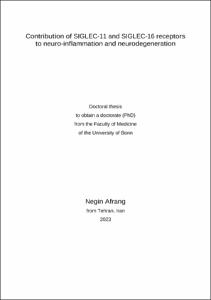Afrang, Negin: Contribution of SIGLEC-11 and SIGLEC-16 receptors to neuro-inflammation and neurodegeneration. - Bonn, 2023. - Dissertation, Rheinische Friedrich-Wilhelms-Universität Bonn.
Online-Ausgabe in bonndoc: https://nbn-resolving.org/urn:nbn:de:hbz:5-69854
Online-Ausgabe in bonndoc: https://nbn-resolving.org/urn:nbn:de:hbz:5-69854
@phdthesis{handle:20.500.11811/10642,
urn: https://nbn-resolving.org/urn:nbn:de:hbz:5-69854,
author = {{Negin Afrang}},
title = {Contribution of SIGLEC-11 and SIGLEC-16 receptors to neuro-inflammation and neurodegeneration},
school = {Rheinische Friedrich-Wilhelms-Universität Bonn},
year = 2023,
month = feb,
note = {Brain aging is a multifactorial process including accumulation of aged lipids and proteins, neuroinflammation and loss of neurons. SIGLEC-11 and SIGLEC-16 are paired opposite inhibitory- versus activatory-signaling receptors on human microglia without any direct homology in mice. Contribution of these paired receptors to brain aging is still unclear.
In this study, the effect of these paired receptors during normal aging was investigated at two different time points (6 and 24 months of age) in humanized inhibitory-signaling SIGLEC-11 versus activatory-signaling SIGLEC-16 transgenic (tg) mice, that ectopically were expressing the respective human receptors in microglia and macrophages. Immunohistochemical analysis of hippocampus and substantia nigra showed that the number of Iba1-positive cells was increased at the age of 24 months in SIGLEC-16 compared to the SIGLEC-11 tg mice and wildtype group. In addition, protein levels of Cd68 were increased in SIGLEC-16 tg mice at 24 months versus the other both groups. In line with the protein level results, gene transcription of the microglial markers, Iba1 and Cd68, increased in SIGLEC-16 tg at 24 months old versus the wildtype control and SIGLEC-11 tg groups. Results also demonstrated that 6 months old SIGLEC-11 tg mice have lower gene transcription levels of the pro-inflammatory cytokines tumor necrosis factor-α and interleukin-1β and the complement proteins including C3 and C4 compared to SIGLEC-16 tg mice. Furthermore, oxidative markers presented higher levels in SIGLEC-16 tg at an age of 24 months compared to the other groups at the similar age. Moreover, 24 months old SIGLEC-16 tg mice showed increased loss of neurons in the hippocampus compared to the wildtype control and SIGLEC-11 tg mice. In parallel, staining of pre- and post-synaptic markers demonstrated higher number of synapses in SIGLEC-11 tg mice at 6 months of age compared to the other experimented groups. Results suggest that activation of microglia as well as the complement cascade are better controlled in SIGLEC-11 tg mice and that increased inflammation might contribute to loss of neurons in SIGLEC-16 tg mice.
Taken together, our study described inhibitory-signaling SIGLEC-11 as neuro- and synapse-protective receptor through aging, while activatory-signaling SIGLEC-16 promotes inflammation and neuronal loss.},
url = {https://hdl.handle.net/20.500.11811/10642}
}
urn: https://nbn-resolving.org/urn:nbn:de:hbz:5-69854,
author = {{Negin Afrang}},
title = {Contribution of SIGLEC-11 and SIGLEC-16 receptors to neuro-inflammation and neurodegeneration},
school = {Rheinische Friedrich-Wilhelms-Universität Bonn},
year = 2023,
month = feb,
note = {Brain aging is a multifactorial process including accumulation of aged lipids and proteins, neuroinflammation and loss of neurons. SIGLEC-11 and SIGLEC-16 are paired opposite inhibitory- versus activatory-signaling receptors on human microglia without any direct homology in mice. Contribution of these paired receptors to brain aging is still unclear.
In this study, the effect of these paired receptors during normal aging was investigated at two different time points (6 and 24 months of age) in humanized inhibitory-signaling SIGLEC-11 versus activatory-signaling SIGLEC-16 transgenic (tg) mice, that ectopically were expressing the respective human receptors in microglia and macrophages. Immunohistochemical analysis of hippocampus and substantia nigra showed that the number of Iba1-positive cells was increased at the age of 24 months in SIGLEC-16 compared to the SIGLEC-11 tg mice and wildtype group. In addition, protein levels of Cd68 were increased in SIGLEC-16 tg mice at 24 months versus the other both groups. In line with the protein level results, gene transcription of the microglial markers, Iba1 and Cd68, increased in SIGLEC-16 tg at 24 months old versus the wildtype control and SIGLEC-11 tg groups. Results also demonstrated that 6 months old SIGLEC-11 tg mice have lower gene transcription levels of the pro-inflammatory cytokines tumor necrosis factor-α and interleukin-1β and the complement proteins including C3 and C4 compared to SIGLEC-16 tg mice. Furthermore, oxidative markers presented higher levels in SIGLEC-16 tg at an age of 24 months compared to the other groups at the similar age. Moreover, 24 months old SIGLEC-16 tg mice showed increased loss of neurons in the hippocampus compared to the wildtype control and SIGLEC-11 tg mice. In parallel, staining of pre- and post-synaptic markers demonstrated higher number of synapses in SIGLEC-11 tg mice at 6 months of age compared to the other experimented groups. Results suggest that activation of microglia as well as the complement cascade are better controlled in SIGLEC-11 tg mice and that increased inflammation might contribute to loss of neurons in SIGLEC-16 tg mice.
Taken together, our study described inhibitory-signaling SIGLEC-11 as neuro- and synapse-protective receptor through aging, while activatory-signaling SIGLEC-16 promotes inflammation and neuronal loss.},
url = {https://hdl.handle.net/20.500.11811/10642}
}






